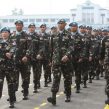
Philippine Armed Forces Adopts New Counter-Insurgency Strategy
Publication: Terrorism Monitor Volume: 8 Issue: 44
By:

The Philippine military’s new operational strategy in Mindanao involves the transfer of Marines from Basilan to Central Mindanao as part of a realignment of forces. Armed Forces of the Philippines (AFP) chief-of-staff Lieutenant General Ricardo David confirmed on November 4 that a Marine brigade is being transferred from Basilan province, where Abu Sayyaf members are hiding, to Central Mindanao, where the Moro Islamic Liberation Front (MILF) is located. The combat units moving to Cotabato City are part of the “national maneuver forces” and are thus capable of being deployed anywhere in the Philippines (GMA News TV, November 4).
The new counter-insurgency plan is set to be implemented in January 2011. As a result of the plan, the Army will become the dominant force in Basilan. The retirement in November of Wesmincom (Western Mindanao Command) commander Lieutenant General Benjamin Dolorfino, a former Marine commandant, may also pave the way for an Army general to be appointed as the next Commander of Wesmincom. Wesmincom covers the two main Abu Sayyaf hideouts, Basilan and Sulu Provinces, and also Tawi-Tawi Province and the Zamboanga Peninsula.
The rise of kidnapping incidents in Central Mindanao prompted the Cotabato City business community and prominent locals to request the return of the Marines to the area. The Marines were stationed in Cotabato City in 2002, but moved to Basilan in order to conduct an offensive against Abu Sayyaf. AFP chief Ricardo David denies that the transfer of the 1st Marine Brigade back to Central Mindanao represents a shift in operational focus from Abu Sayyaf to the MILF. National Defense Secretary Voltaire Gazmin maintains that the transfer is a response to requests for more security from local people and that the move has support from religious and government leaders (GMA News TV, November 4).
The transfer of forces to Cotabato City was made possible by the success of the relentless, intelligence-driven military operations that have significantly reduced the threat from Abu Sayyaf in Basilan. According to Lieutenant General Dolorfino, Abu Sayyaf “has been on the run, so many of their leaders have been neutralized” (Philippine Daily Inquirer, November 5). Abu Sayyaf’s strength is now estimated at 400 fighters, less than half the 2002 total.
Other insurgent groups in the Philippines are also weakened or in conflict. In Samar, Bicol, Carage, Northern Luzon, Central Luzon and Negros, where the communist New People’s Army (NPA) insurgency is still ongoing, the NPA’s strength has been reduced from its 25,000 fighters in the 1980s to 5,000 fighters today (Philippine Daily Inquirer, November 20). In Central Mindanao, the MILF is suffering from factional rivalries and has been fighting with the Moro National Liberation Front (MNLF) since March 2009 (Zamboanga Today, July 31).
The new anti-insurgency plan continues the Arroyo-era goal of “finishing off” Abu Sayyaf and other insurgent groups, but the strategy of force is no longer the focus. Lieutenant General Raymundo Ferrer, the new Wesmincom commander, says the “military operation has been shifted to peace and development as a new strategy in addressing the remnants of the militants and the root causes of terrorism in the region.” Ferrer says that the AFP is “working on the framework of securing peace and development because development will overcome the problem of insurgencies and quell the threat of terrorism (Philippine Star, November 23).
In Basilan, for example, the strategy involves surgical military operations enhanced by civil-military economic development programs that are intended to separate public support from Abu Sayyaf and keep the fighters on the run (Sun Star [Zamboanga], May 26). No longer will the AFP engage in large-scale military operations in Basilan or comb the jungles searching for Abu Sayyaf members concealed among the local population. Such operations are “counter-productive” because they lead to large displacements of people and cause locals to have negative perceptions of the military (Asia Times, June 19).
In Central Mindanao, the transfer of troops to Cotabato City may be a way to gain leverage and pressure the MILF to revive negotiations with the government. Talks have stalled since the Supreme Court stopped the government from signing the Memorandum of Agreement on Ancestral Domain (MOA-AD) in 2008, which would have expanded the existing Autonomous Region in Muslim Mindanao (ARMM) to an additional 712 villages. President Benigno Aquino III has declared peace talks with the MILF to be a “top priority” and is trying to bring the MILF back into negotiations (Philippine Star, November 1; ABS.CBN News, November 20).
The military developed this new strategy with input from civil society. New aspects of the anti-insurgency plan that were absent in the expiring and much criticized “Bantay Laya” plan (associated with a wave of extrajudicial killings) include greater transparency, an end to human rights violations, the promotion of good governance within local administrations and the AFP, and using less combat in favor of more peaceful tactics (Philippine Daily Inquirer, November 21). Under the new strategy the military will cease to use the words “destroy,” “neutralize” and “terminate” and instead will refer to “winning the peace.” Armed Forces chief Ricardo David gives his support to the plan because he believes to achieve victory “you have to have a clear human rights advocacy" (GMA News TV, November 16).
Note:
1. Interview with an official from the Philippine Department of Defense.





